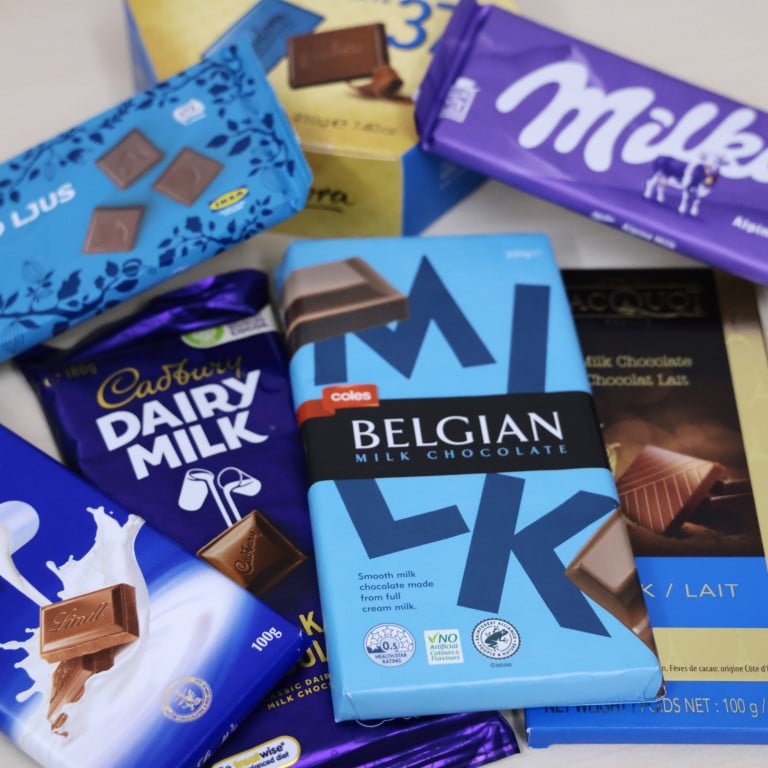
views
 Chocolate brands presented by the Consumer Council at Monday’s press briefing. Photo: May TseHong KongHong Kong economyHong Kong consumer watchdog warns of heavy metal traces in 29 chocolate samples tested, with 1 exceeding EU limits
Chocolate brands presented by the Consumer Council at Monday’s press briefing. Photo: May TseHong KongHong Kong economyHong Kong consumer watchdog warns of heavy metal traces in 29 chocolate samples tested, with 1 exceeding EU limits
- Consumer Council also points out both milk and dark chocolate considered ‘high-sugar’ food
- In separate tests on plant-based milk, it says nutrients in such products may not match those found in cow’s milk
Hong Kong’s consumer watchdog on Monday revealed that all 29 chocolate samples it tested were found to contain traces of the heavy metal cadmium, with one batch exceeding permitted EU levels.
The Consumer Council said both milk and dark chocolate were considered “high-sugar foods” loaded with fatty content.
The council’s survey also looked at plant-based milk. It warned that such products might not work as a complete substitute to nutrients available in cow’s milk.
“Prolonged intake of foods of high cadmium content might pose risks to kidney functions,” Kyrus Siu King-wai, chairman of the council’s publicity and community relations committee, said.
“Recent studies indicate that for an average adult, weekly chocolate intake should be limited to less than 100 grams.”
A total of 29 chocolate samples – 20 of the dark variety and nine milk types – were tested, with unit prices ranging from HK$1 per 10 grams to HK$32. The council looked at the products’ stated nutritional values such as sugar, protein, and trans fat levels, as well as heavy metal and carcinogenic contaminant marks.
Hong Kong does not have a legal limit for cadmium in chocolate, so the council turned to standards set out in the European Commission Regulation for cocoa products.
The EU standards as of April 2023 stipulate a maximum cadmium limit in chocolate with cocoa content of or more than 50 per cent as 0.8mg/kg, and 0.3mg/kg for those lower than 50 per cent but equal or greater than 30 per cent, while the limit for those less than 30 per cent is 0.1mg/kg.
All samples were detected with cadmium, but only one – Amedei’s Blanco De Criollo Extra Dark Chocolate – returned a result of 0.937mg/kg, exceeding the limit of 0.8mg/kg.
The Post has reached out to Amedei for a response.
The council added that 23 chocolate samples were detected with possibly carcinogenic contaminants – polycyclic aromatic hydrocarbons – but these were within EU limits.
Average milk chocolate samples were generally 90.8 per cent higher in sugar content than dark chocolate in council tests, but the watchdog added that dark chocolate samples were 28.5 per cent higher in average fat content than milk chocolate ones.
All dark chocolate samples apart from two with the label “no added sugar” were found to have more than 15 grams of sugar per 100 gram – reaching “high sugar” levels, while the milk chocolate samples had an average sugar content of 53.8 grams per 100 grams.
The dark chocolate tested had an average total fat content of 42.8g per 100 grams, with the highest reaching 50.7 grams per 100 grams, while the milk chocolate samples had an average fat content of 33.3 grams per 100 grams.
The council also tested 39 plant-based milk products, including soy, oat, almond, coconut, and rice milk, finding significant differences in nutritional content.
Tests performed on the 12 brands of soy milk yielded the highest average protein content at 3.26 grams per 100ml. It would take about five cups of oat or almond milk to yield the same amount of protein.
The watchdog also found plant-based milk had far lower non-added calcium content – ranging from 2.55mg to 76.12mg – than low-fat milk at 125mg. It would take 125 cups of coconut milk without additions to achieve the calcium contained in one cup of low-fat milk.
The council also advised consumers to inspect nutrition labels, as the definition of high calcium could be measured per 100 kcal or per 100ml. Samples labelled as high calcium according to one measurement might not meet the requirements of another mark, the watchdog cautioned.
“Consumers wishing to replace cow’s milk with plant milk should examine nutrition labels carefully and choose a fortified product according to their intake needs, while at the same time obtain adequate protein, calcium, and different vitamins from other dietary sources,” Siu said.




















Comments
0 comment